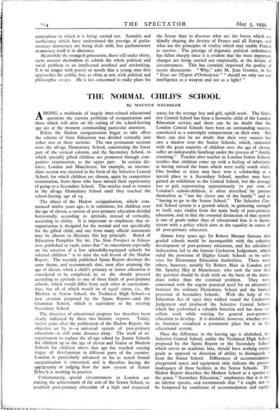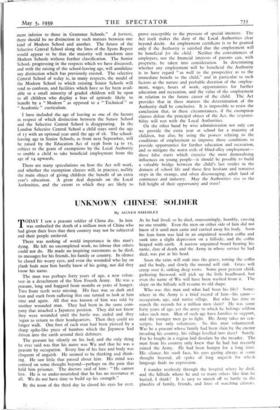THE NORMAL CHILD'S SCHOOL
By MAGNUS WECHSLER
AMONG a multitude of largely inter-related educational questions the current problems of reorganisation and those which will arise on the raising of the school-leaving age are at the moment commanding particular attention.
Before the Hadow reorganisation began to take effect the scheme of State Education was divided vertically into either two or three sections. The two permanent sections were the all-age Elementary School, constituting the lower part of the vertical column, and the Secondary School, to which specially gifted children are promoted through com- petitive examination, as the upper part. In certain dis- tricts, London and Manchester, for example, an interme- diate section was inserted in the form of the Selective Central School, for which children are chosen, again by competitive examination, from those who have missed their opportunity of going to a Secondary School. The residue used to remain in the all-age Elementary School until they reached the school-leaving age of 14.
The object of the Hadow reorganisation, which com- menced twelve years ago, is to substitute, for children over the age of eleven, a system of post-primary education divided horizontally according to aptitude, instead of vertically, according to ability. It is important to emphasise that re- organisation is designed for the normal and not specifically for the gifted child, and one from many official statements may be chosen to illustrate this key principle. Board of Education Pamphlet No. 6o, The New Prospect in Educa- tion, published in 1928, states that " to concentrate especially on the erection of a few splendidly-equipped schools for selected children " is to miss the real lesson of the Hadow Report. The recently published Spens Report develops the same theme, and recommends that, soon after attaining the age of eleven, when a child's primary or junior education is considered to be completed, he or she should proceed according to aptitude to one of three kinds of post-primary schools, which would differ from each other in curriculum- bias, but all of which would be of equal status, i.e., the Modern or Senior School, the Technical High School—a new creation proposed by the Spens Report—and the Grammar School, which is equivalent to the existing Secondary School.
The direction of educational progress has therefore been clearly indicated by these two historic reports. Today, twelve years after the publication of the Hadow Report, the objective set by it—a universal system of post-primary education—is still some distance away. The work of re- organisation to replace the all-age school by Junior Schools for children up to the age of eleven and Senior or Modern Schools for children above that age has reached varying stages of development in different parts of the country. London is particularly advanced so far as actual formal reorganisation is concerned, and is therefore having the opprtunity of judging how the new system of Senior Schm!'s is working in practice.
Unfortunately, special circumstances in London are making the achievement of the aim of the Senior School, to establish post-primary education of a high and respected status for the average boy and girl, uphill work. The Selec- tive Central School has been a favourite child of the London Education service, and there can be no doubt that the London Central Schools have been an outstanding success, considered as a watertight compartment on their own. But there can also be no doubt that their very success has cast a shadow over the Senior Schools, which, entrusted with the great majority of children over the age of eleven, suffer an indisputable handicap under the process of " double creaming." Teacher after teacher in London Senior Schools testifies that children come up with a feeling of inferiority at having missed the boats which were really worth while. One brother or sister may have won a scholarship or a special place to a Secondary School, another may have gained an exhibition to the Central School, but the average boy or girl, representing approximately 70 per cent. of London's school-children, is often described by parents themselves as " not the clever one of the family " and as " having to go to the Senior School." The Selective Cen- tral School system is a growth which, in gathering strength to itself, saps vitality from the main body of post-primary education, and in that the essential distinction of that system is one of grade rather than of educational bias it is incon- sistent with a policy which aims at the equality in status of all post-primary education.
Almost forty years ago Sir Robert Morant foresaw that graded schools would be incompatible with the cohesive development of post-primary education, and his calculated indiscretion led to the famous Cockerton Judgement, which ruled the provision of Higher Grade Schools to be ultra wires for Elementary Education Authorities. There were others, however, notably Sir Robert Blair in London and Mr. Spurley Hey in Manchester, who took the view that the question should be dealt with on the basis of the imme- diate rather than the eventual problem. They were concerned with the urgent practical need for an alternative between the ordinary Elementary School and the limited provision of Secondary Schools. With the help of the Education Act of 1902 they walked round the Cockerton Judgement and produced the Selective Central School, which has performed a valuable function and has done ex- cellent work while waiting for general post-primary education to develop. It is doubtful, however, whether even its founders visualised a permanent place for it in the educational system.
Once the difference in the leaving age is abolished, the Selective Central School, unlike the Technical High School proposed by the Spens Report or the Secondary School which serves an academic bias, should have nothing except grade as opposed to direction of ability to distinguish it from the Senior School. Differences of accommodation, playground space, and equipment only indicate the present inadequacy of these facilities in the Senior Schools. The Hadow Report describes the Modern School as a species of the genus " Secondary Education," emphasises that it is not an inferior species, and recommends that " it ought not .to be hampered by conditions of accommodation end equIP- ment inferior to those in Grammar Schools." A fortiori, there should be no distinction in such matters between one kind of Modern School and another. The future of the Selective Central School along the lines of the Spens Report would appear to be that the majority will transform into Modem Schools without further classification. The Senior School, progressing in the respects which we have discussed, and with the raising of the school-leaving age, will annihilate any distinction which has previously existed. The selective Central School of today is, in many respects, the model of the Modern School to which existing Senior Schools will tend to conform, and facilities which have so far been avail- able to a small minority of graded children will be open to all children who display a bias of aptitude likely to benefit by a " Modem " as opposed to a " Technical " or " Academic " curriculum.
I have included the age of leaving as one of the factors in respect of which distinction between the Senior School and the Selective Central School is disappearing. In the London Selective Central School a child stays until the age of 15 with an optional year until the age of 16. The school- leaving age in Senior Schools, as from next September, will be raised by the Education Act of 1936 from 14 to 15, subject to the grant of exemptions by the Local Authority to enable a child to take beneficial employment from the age of 14 upwards.
There are many speculations on how the Act will work, and whether the exemption clauses will, in practice, nullify the main object of giving children the benefit of an extra year's education. A great deal depends on the Local Authorities, and the extent to which they are likely to prove susceptible to the pressure of special interests. The Act itself makes the duty of the Local Authorities clear beyond doubt. An employment certificate is to be granted only if the Authority is satisfied that the employment will be beneficial for the child. Neither the conveniences of employers, nor the financial interests of parents can, with propriety, be taken into consideration. In determining whether any employment will be beneficial the Authority is to have regard " as well to the prospective as to the immediate benefit to the child," and in particular to such factors as the nature and probable duration of the employ- ment, wages, hours of work, opportunities for further education and recreation, and the value of the employment in relation to the future career of the child. The Act provides that in these matters the determination of the Authority shall be conclusive. It is impossible to resist the conclusion that, in these circumstances, if the exemption clauses defeat the principal object of the Act, the responsi- bility will rest with the Local Authorities.
On the other hand by wise administration not only can we provide the extra year at school for a majority of children, but also, by using the powers relating to the conditions of employment to improve those conditions to provide opportunties for further education and recreation, and to mitigate the worst evils of blind-alley employment— those false starts which exercise the most demoralising influences on young people—it should be possible to build a valuable bridge between the child's last strides in the domain of school life and those first hesitant and tentative steps in the strange, and often discouraging, adult land of commerce and industry. May the Authorities rise to the full height of their opportunity and trust!















































 Previous page
Previous page